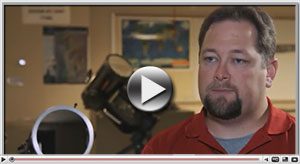IU East faculty expert provides best viewing tips for Total Eclipse
Wes Tobin is an assistant professor of physics at Indiana University East. Tobin recently answered questions on the Total Solar Eclipse occurring on Monday, August 21. The campus and community are invited to attend a viewing event for the Total Eclipse from 1-4 p.m. at the West End Bank Plaza, located outside the Student Events and Activities Center.

Assistant Professor of Physics Wes Tobin talks about the Total Solar Eclipse happening on August 21.
A livestream of the eclipse will be available during the event at http://go.iu.edu/1Gwm.
August 21 is also the first day of classes for the fall semester at IU East and across the Indiana University system.
The IU East Campus Library has also put together a 2017 Libguide to provide additional information on the Total Solar Eclipse. The libguide is at iue.libguides.com/Eclipse2017.
Tobin’s research interests include observational astronomy including the areas of observations and analyses of peculiar velocity structures in galaxy clusters; spectroscopic observations of parent stars of extrasolar planets; and high-precision photometric methods in detecting variability and extrasolar planets. He has published articles for European Journal of Physics and Monthly Notices of the Royal Astronomical Society.
Tobin joined IU East in October 2015. He received his Doctor of Education in Science from Ball State University. He received his M.S. in Astrophysics from Iowa State University and his Bachelor of Science in Physics and Mathematics from Indiana State University in Terre Haute, Indiana.
Q&A with Assistant Professor Wes Tobin
What is unique about this eclipse? Why is it getting so much attention?
There is a total solar eclipse, on average, about every 18 months, so they’re not really rare events. However, for a person to see totality is rare because the moon’s shadow is very small compared to the surface of the Earth. In many places (including Richmond, Indiana), totality has not occurred in more than 1,000 years, though we came very close with the 1994 Annular Eclipse.
This eclipse, dubbed the Great American Eclipse, is getting a lot of attention because it’s the first total eclipse since 1979 where totality can be seen from the United States or Canada, and it is one of the few that will travel coast-to-coast. We were able to see annular eclipses in 1984 and 1994, where the moon’s angular size is too small to completely cover the sun, but not a total eclipse of the sun.
Where are the best viewing locations in east central Indiana and west central Ohio?
Generally, as long as you can see the sun, everyone in the region will have the same view. The magnitude of the eclipse is larger as you move southwestward, but for significant visual effects, you would need to be located very near the path of totality, such as Kentucky or Tennessee. However, since there will be only a little change in the ambient light, the best locations will include locations where telescopes (with solar filters) would be set up for public viewing.
What can people watching the eclipse in the Wayne County area expect to see?
Most people will probably not notice a difference in the brightness of the sunlight during the eclipse. However, a keen eye of the light that passes through trees or other small openings could appear different. Light that passes through small openings tends to diffract, which causes the image of the Sun to be focused. During the eclipse, part of the Sun becomes covered, changing the shape, and so the shape of the focused images will change accordingly.
What is the best and safest way to view the solar eclipse?
First, it’s important to remember that it is not safe to look at the sun without a solar filter, even during the eclipse. Since the sun is not completely covered, it could still damage your eyes if you try to look at it without an appropriate filter. Furthermore, sunglasses are not safe to use – only specialized solar filters are appropriate for directly viewing the sun or the solar eclipse from our region.
The safest ways to watch the eclipse is by viewing the image produced by a small hole (pinhole) in a piece of paper, or by using solar filter glasses. The best way, though, is to view the solar eclipse through a telescope that has a solar filter.
What about the use of a telescope or camera to take photos of the eclipse?
Just like your eyes, a camera can be damaged if pointed directly at the sun when the shutter opens. Only use a camera or a telescope with a solar filter that is specifically designed for it.
What can we learn from this eclipse? How can this be a learning experience for people of all ages in our community?
An eclipse helps to highlight the size, scale and positions of the earth, moon and the sun in our solar system. The sun is about 400 times larger than the moon, but it is about 400 times further away. This relationship allows the sun and the moon to appear almost the same size in the sky. When the moon is a little closer to us in its orbit, like it is now, it more completely blocks out the Sun during an eclipse. If the moon happened to be a bit further away from us in its orbit, we would see an annular eclipse instead of a total eclipse, where the moon appears too small to completely block out the sun.

